- home
- BAKERECIPES
BakeRecipes
Bringing real baking into your home with deliciously simple recipes.
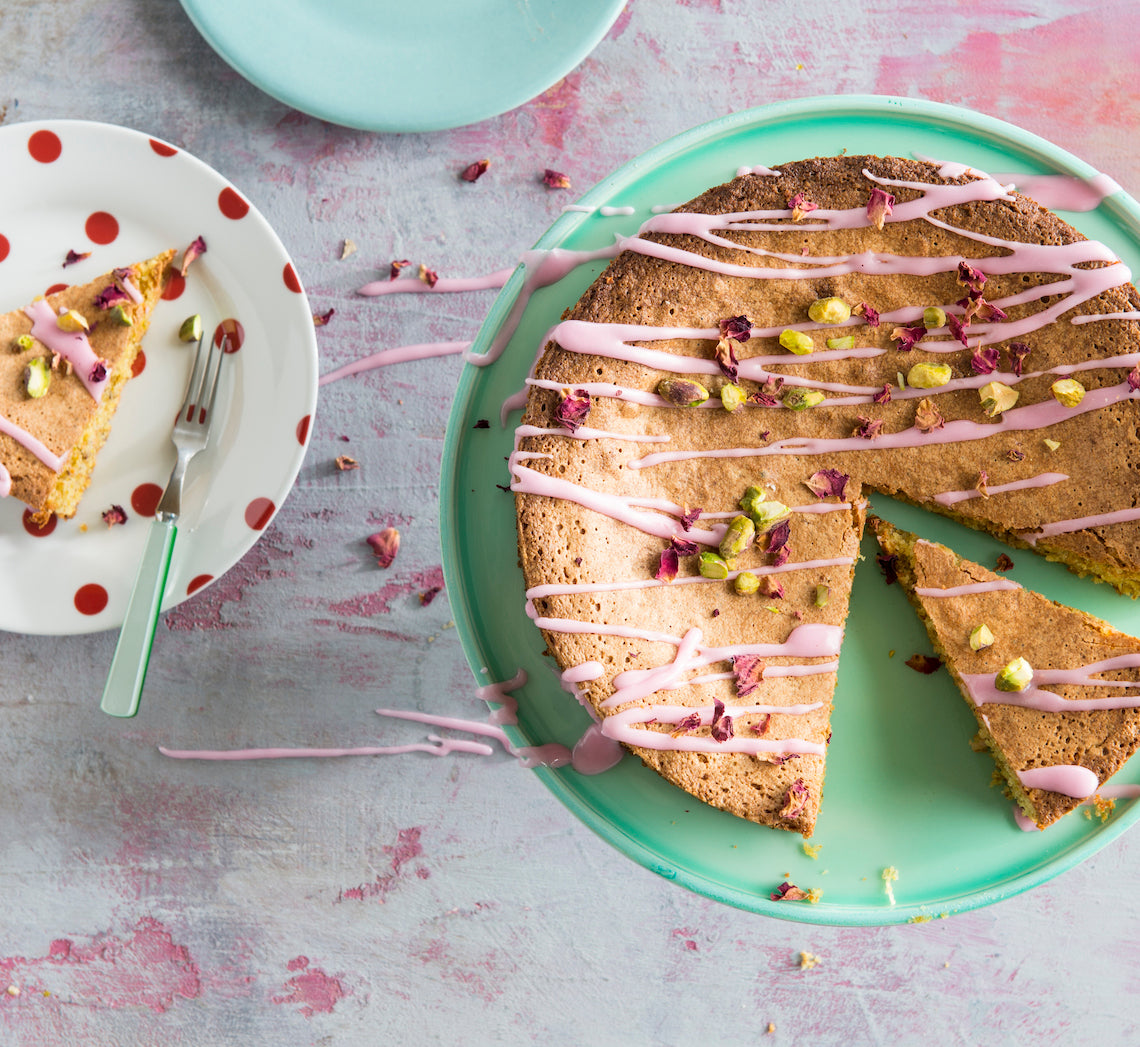
Prep 30min (+1hr cooling time)Bake 30minMakes 8-10 serves
This gluten-free and dairy-free recipe, with its subtle lemon flavour teamed with an aromatic rosewater icing and light nutty texture, is the perfect afternoon-tea cake. It will dip slightly in the centre due to its delicate nature but this is just a sign of how lovely and light it is.
Ingredients
Light olive oil, to grease
100g (1 cup) almond meal
100g (¾ cup) raw unsalted pistachios, toasted and finely ground
90g (½ cup) instant polenta or wholegrain corn flour
2 teaspoons gluten-free baking powder
3 eggs, at room temperature
165g (¾ cup) caster sugar
125ml (½ cup) light olive oil
1 lemon, rind finely shredded, juiced
extra raw unsalted pistachios, toasted and coarsely chopped, to decorate
dried rose petals (optional), to decorate
Lemon and rosewater icing
125g (1 cup) pure icing sugar
1 tablespoon (about) strained fresh lemon juice
1 teaspoon rosewater
gluten-free pink or rose food colouring, to tint
Method
- Preheat oven to 180°C (160°C fan-forced). Brush a 20cm springform cake tin with olive oil and line the base with non-stick baking paper.
- Place the almond meal, ground pistachios, polenta and baking powder in a medium bowl and use a whisk to stir to combine and remove any lumps. Set aside.
- Use an electric mixer with a whisk attachment to whisk the eggs and sugar on medium-high speed until thick and pale and a ribbon trail forms when the whisk is lifted. Whisk in the olive oil, 2 tablespoons of the lemon juice and the lemon rind.
- Add the dry ingredients to the egg mixture and use a spatula or large metal spoon to fold until evenly combined. Pour into the prepared cake tin and bake for 30 minutes or until a skewer inserted in the centre comes out clean. Stand the cake in the tin on a wire rack for 10 minutes before removing the sides of the tin. Set aside to cool completely.
- To make the lemon and rosewater icing, sift the icing sugar into a medium bowl. Gradually stir in the 1 tablespoon lemon juice and the rosewater until the mixture is smooth and has a thick coating consistency, adding a little more juice if needed. Cover with plastic wrap and set aside at room temperature until ready to use.
- Drizzle the cooled cake with the icing and then sprinkle with extra pistachio nuts and dried rose petals, if using. Set aside for 30 minutes or until the icing has set before serving in wedges.
Baker's Tips
- This cake will keep in an airtight container at room temperature for up to 4 days.
This recipe is from Anneka's SBS Food online column Bakeproof: Gluten-free baking. Click here for more Bakeproof columns and recipes.
Photography by Alan Benson.
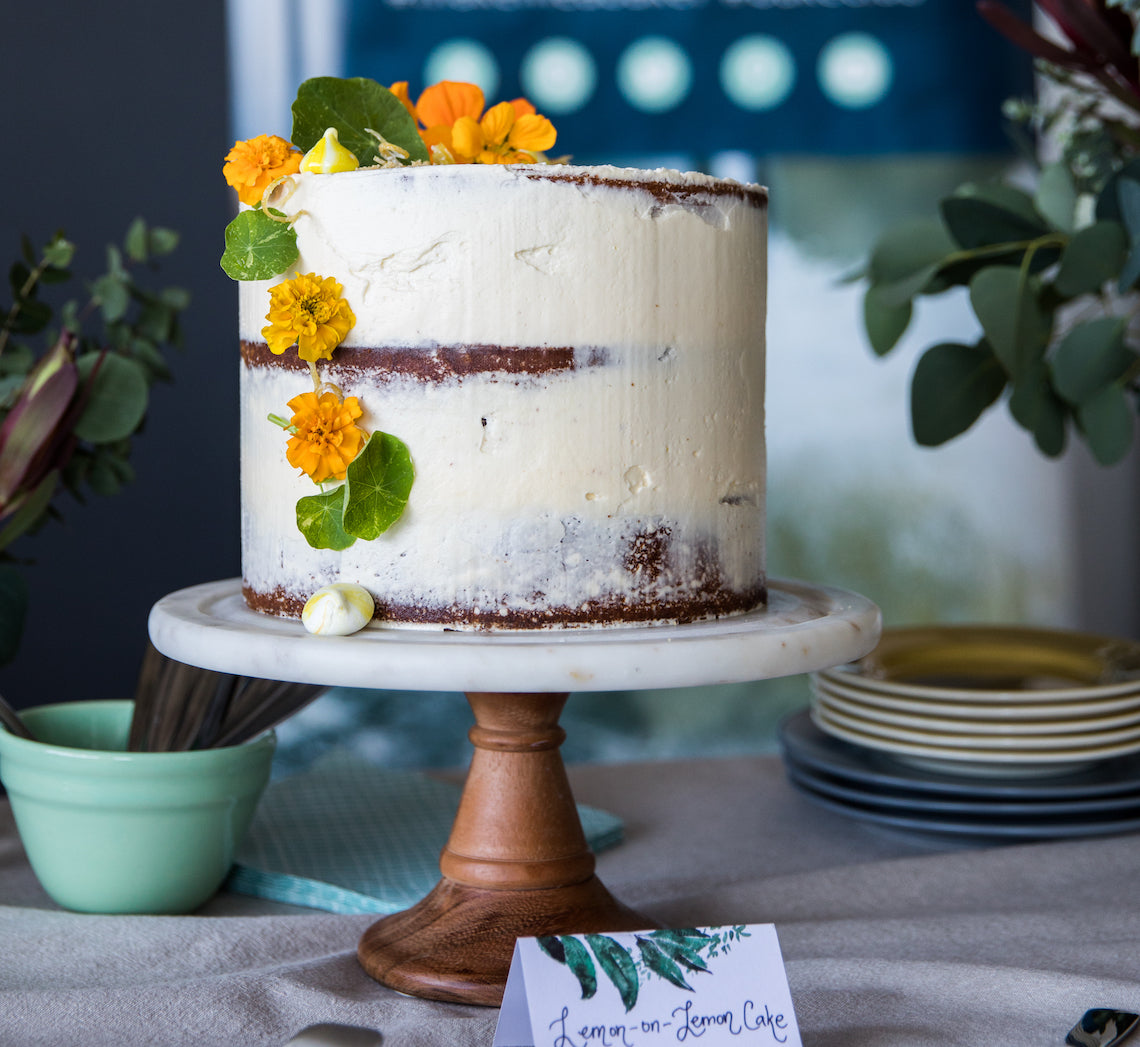
Prep 1hr45min (+ preparation time for Lemon Drizzle Pound Cakes, Swiss Meringue Buttercream and Striped Meringue Kisses)Bake 20minMakes about 20 serves
Created by Make Me a Baker student Janet Jackson for her graduation, this gorgeous cake brings together a selection of the techniques that she learnt during the 6-month program.
Janet said, "I love to bake cakes and have always admired decorated cakes but have never had the confidence to try one for myself. For my graduation bake, I wanted to bake and decorate a cake using produce from my garden at home and techniques I had learnt through the MMAB program. I trialled many different versions of lemon cake, some with poppy seeds and others with sour cream and Greek yoghurt, before settling on this delicious lemon drizzle cake which is lusciously moist and filled with the zing of freshly picked lemons."
Ingredients
Edible flowers, to decorate (optional)
3 Lemon Drizzle Pound Cakes
2 quantities Swiss Meringue Buttercream
5-15 yellow Striped Meringue Kisses
Lemon Curd
2 eggs, at room temperature
2 egg yolks, at room temperature
165g (¾ cup) caster sugar
80g unsalted butter, diced
2 tablespoons strained freshly squeezed lemon juice
Finely grated zest of 2 lemons
Lemon Crumb
60g unsalted butter, chilled, diced
80g plain flour
50g caster sugar
1 tablespoon strained fresh lemon juice
1 teaspoon finely grated lemon zest
Candied Lemon Curls
220g (1 cup) caster sugar
250ml (1 cup) water
½ lemon
Method
- To make the Lemon Curd, use a balloon whisk to whisk the whole egg, egg yolk and sugar in a medium saucepan until smooth. Add the butter, juice and zest and stir continuously with a wooden spoon until the mixture thickens enough to coat the back of a spoon (if you run your finger across the back of the spoon through the curd a line should remain when ready and the mixture should be 70°C on a sugar thermometer). Do not boil. Stain through a sieve into a bowl (see Baker’s Tips). Cover the surface of the curd with plastic wrap and place in the fridge for at least 2 hours before using.
- To make the Lemon Crumb, preheat oven to 180°C (160°C fan-forced) and line a baking tray with baking paper. Place all ingredients into the bowl of a food processor and process until the mixture just comes together in a dough. Use your fingers to press the dough onto the lined baking tray until about 3mm thick and bake in preheated oven for 10-12 minutes or until pale golden. Remove from oven and set aside to cool completely on the tray. Once cooled, break up the biscuit and process in the food processor again using the pulse button until a coarse crumb forms. Transfer the crumbs back to the lined tray and bake for a further 8 minutes or until golden. Set aside to cool on the tray (see Baker’s Tips).
- To make the Candied Lemon Curls, line a baking tray with baking paper. Use a vegetable peeler to remove the rind from the lemon in long strips. Use a small sharp knife to remove any white pitch from the rind and then cut the rind into long, thin strips. Combine the sugar and water in a small saucepan and stir over medium-low heat until the sugar dissolves completely. Add the lemon rind, bring to a simmer and simmer over medium-low heat for 20 minutes or until the rind is translucent. Remove the saucepan from the heat and use a skewer to remove the lemon strips, one at a time, from the syrup and twist around the round handle of a wooden spoon to make the curls. Allow to stand for about 5 seconds and then remove carefully from the wooden spoon by sliding off the end of the handle, using the skewer to help carefully release them if necessary. Set aside on the lined tray. Repeat with the remaining lemon rind strips.
- To assemble the cake, use a large sharp serrated knife to level the tops of the Lemon Drizzle Pound Cakes if necessary. Place one of the cakes on a serving plate or cake stand. Spoon about a quarter of the Swiss Meringue Buttercream into a piping bag fitted with a #11 (1.1cm) round piping nozzle and pipe a border of buttercream around the top outside edge of the cake. Spoon about ⅓ cup of the chilled lemon curd into the centre of the cake and spread evenly to the buttercream. Spoon about ⅓ cup of the remaining buttercream in small dollops over the lemon curd and use a small palette knife or the back of a metal spoon to spread gently to cover the curd. Continue to layer the cake, curd and buttercream finishing with a cake layer.
- Spread the top and sides of the cake with the remaining buttercream creating a semi-naked look. Decorate with the Striped Meringue Kisses, Lemon Crumb and Candied Lemon Curls and embellish with fresh flowers if desired.
Baker's Tips
- This recipe will make about 1½ cups of Lemon Curd, but you will only need about 1 cup of the lemon curd for this cake. The leftover curd will keep in a sealed sterilized jar in the fridge for up to 2 weeks.
- The Lemon Crumb will keep in an airtight container or jar at room temperature for up to 2 weeks.
- The Lemon Curls will keep in an airtight container at room temperature for up to 1 week.
-
Janet baked the cakes the day before and let them stand overnight allowing the lemon drizzle to soak in. The Lemon Curd was made a couple of days ahead of time and stored in the fridge to thicken and develop flavour. She also made the Candied Lemon Curls and Lemon Crumb well ahead of time so she could concentrate on the assembly and decoration of the cake on the day of Graduation.

Prep 20min(+ 1hr cooling time)Bake 35-40minMakes 10 serves
Inspired by the wild rosemary found growing on the Gallipoli peninsula and the symbolic wearing of sprigs as a sign of remembrance for those who have made the ultimate sacrifice, this cake is the perfect way to pay your respects through your baking on Anzac Day. It's a simple cake, made special by the rosemary-infused syrup and is equally good accompanied by a cup of tea or lashings of cream or vanilla ice-cream for dessert (particularly when served while still warm)!
Ingredients
Olive oil, to grease
150g (5¼oz) caster sugar
125g (4½oz) almond meal
75g (½ cup/2¾oz) self-raising flour
180ml (¾ cup/6fl oz) olive oil
3 eggs, at room temperature
2 lemons, rind finely grated
40g (1½oz) flaked almonds
Fresh rosemary flowers (optional), to decorate
Lemon & Rosemary Syrup
60ml (¼ cup/2fl oz) strained fresh lemon juice
60ml (¼ cup/2fl oz) water
110g (½ cup/4oz) caster sugar
4 x 10cm sprigs fresh rosemary
Method
- Preheat oven to 180°C/350°F (160°C/315°F fan-forced). Brush a 20cm/8in spring form tin with olive oil and line the base with non-stick baking paper.
- Combine the sugar, almond meal and flour in a large bowl. Whisk together the olive oil, eggs and lemon rind until well combined. Add to the almond meal mixture and use a balloon whisk or spatula to stir until just evenly combined.
- Pour into the prepared tin and spread with the back of a spoon. Sprinkle evenly with the flaked almonds. Bake in preheated oven for 35-40 minutes or until a skewer inserted in the centre comes out clean. Stand the cake in the tin for 5 minutes before turning transferring to a wire rack sitting over a tray.
- Meanwhile, to make the Lemon & Rosemary Syrup, combine the lemon juice, water and sugar in a small saucepan and stir over medium heat until the sugar dissolves. Add the rosemary sprigs, bring to a simmer and simmer for 5 minutes or until reduced by about half.
- Slowly pour the hot syrup over the warm cake, allowing it to soak in as much as possible. Cool to room temperature (this will take about 1 hour). Decorate with the rosemary flowers (if using) and serve in slices.
Baker's Tip
- This cake will keep in an airtight container at room temperature in a cool spot for up to 3 days.
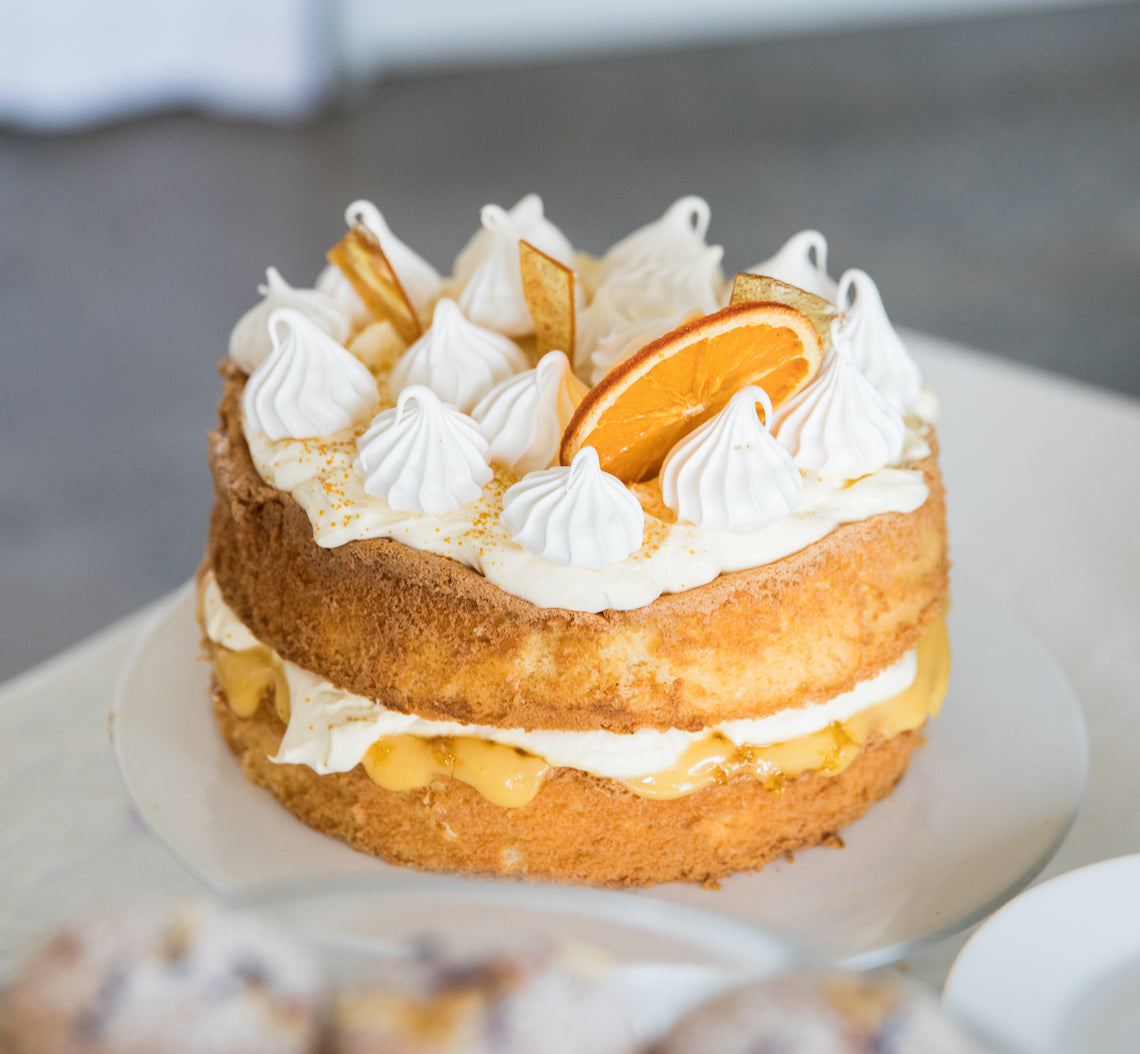
Prep 1.5hr (+ Meringue Rosettes prep)Bake 18-20minMakes 8-10 serves
An absolute must-try for any citrus fan, this light-as-air cake is the ultimate balance between light sponge, mouth-puckering lemon curd and beautiful hand-made adornments.
Created by Make Me a Baker student, Cate Tibbertsma for her graduation, this cake is a nostalgic one "that will fill your belly with sweet memories" as Cate says.
Ingredients
125ml (½ cup) thickened cream
125g (½ cup) sour cream
1 tablespoon pure icing sugar, sifted
1 teaspoon Citrus Dust (see recipe below), plus extra to sprinkle
Meringue Rosettes (get Cate's meringue recipe HERE), to decorate
Oven-dried orange slices (optional), to decorate
Lemon Curd
2 eggs, at room temperature
2 egg yolks, at room temperature
165g (3/4 cup) caster sugar
80g unsalted butter, diced
2 lemons, zest finely grated and juiced
Sponge Layers
Melted butter to grease
4 fresh eggs, at room temperature
1½ teaspoons natural vanilla essence or extract
165g (3/4 cup) caster sugar
60ml (1/4 cup) milk
30g butter, diced
110g (3/4 cup) self-raising flour
30g (1/4 cup) cornflour
Citrus Syrup
110g (½ cup) caster sugar
60ml (1/4 cup) strained fresh lemon juice
60ml (1/4 cup) strained fresh orange juice
Citrus Toffee Shards
Oil spray
100g caster sugar
2½ tablespoons water
1 tablespoon liquid glucose
½ teaspoon Citrus Dust (see recipe below), to sprinkle
Lemon Curd
- Combine the whole eggs, yolks and sugar in a small saucepan and stir with a whisk until smooth. Add the butter and the lemon juice and zest.
- Place the saucepan over a low heat and stir constantly with the whisk until thickened and the mixture reaches 75°C on a sugar thermometer.
- Strain through a sieve into a sterilised jar or glass container with lid. Refrigerate until required (see Baker’s Tips).
Citrus Toffee Shards
- Line a baking tray with non-stick baking paper and spray lightly with oil; set aside. Combine the caster sugar, water and the liquid glucose in a small saucepan. Stir over a low heat until the sugar dissolves. Stop stirring when it starts to boil and brush down the inside of the saucepan with a wet pastry brush to dissolve any crystals that have formed on the surface. Boil until the syrup turns a dark caramel colour (see Baker's Tips).
- Immediately pour the caramel over the entire surface of the baking sheet to create a thin layer. Sprinkle with the Citrus Dust. Set aside to cool and set. When completely cool, transfer to a sealed airtight container together with the baking paper.
Sponge Layers
- Position the oven rack in the middle of the oven and then preheat it to 180°C (160°C fan-forced). Brush two 18cm springform tins with melted butter to grease and line the base of each with a sheet of non-stick baking paper. Combine butter and milk in a small saucepan and set aside. Combine the Citrus Syrup ingredients in a separate small saucepan and set aside also.
- Use an electric mixer with a whisk attachment on medium-high speed to whisk the eggs and vanilla in a medium bowl until frothy. Add the sugar a spoonful at a time, whisking well between each addition, until the mixture is very thick and pale and the sugar has dissolved (this will take about 8 minutes). Lift the whisk out of the mixture and slowly draw a figure eight, if the trail stays on the surface long enough for you to finish drawing then the mixture is ready. If not, continue to whisk for a further minute and then test again.
- Meanwhile, heat the milk and butter in a small saucepan over medium heat until the butter melts and the mixture is almost simmering. Remove from the heat. Pour the hot milk mixture down the side of the bowl and then sift the flour and cornflour together over the egg mixture. Immediately whisk briefly again with the electric mixer on low speed, until the flour mixture is just incorporated (make sure there is no flour caught at the bottom of the bowl and be careful not to over mix).
- Divide the mixture evenly between the cake tins (see Baker's Tips) and gently tap the tins on the bench top three times to settle the mixture. Bake in preheated oven for 18-20 minutes or until the cakes are a pale golden colour, spring back when lightly touched in the centre and start pulling away from the sides of the tins.
Citrus Syrup
- About 5 minutes before the Sponge Layers finish baking, place the saucepan with the Citrus Syrup ingredients over a medium heat and stir until the sugar dissolves. Bring to a boil then reduce to a very gentle simmer to keep warm.
- Remove sponges from the oven and immediately use a small palette knife to loosen the top of the sponges from the tins and turn onto a wire rack lined with a tea towel. Remove the baking paper and carefully turn the hot sponges back on their base onto a rack over a tray. Immediately pour hot syrup over the hot sponge layers. Set aside to cool completely before layering.
To Assemble
- Use an electric hand mixer with a whisk attachment or a balloon whisk to whisk the thickened cream, sour cream and icing sugar together in a medium bowl, until soft peaks form.
- Place one sponge layer on a serving plate or cake stand. Spread about 1/2 cup of curd over the sponge layer and use a small sieve to sprinkle the Citrus Dust over the curd. Spread about half the cream mixture over the curd layer, spreading gently to avoid over-working the cream. Top with the remaining sponge layer. Spread another 1/2 cup of curd on top followed by the remaining cream mixture, again spreading gently so you don’t over work it.
- Decorate with the Meringue Rosettes and Citrus Toffee Shards and sprinkle with extra Citrus Dust. Embellish with oven-dried orange slices, if desired. Serve immediately or refrigerate for up to 2 hours (see Baker's Tips).
ORANGE CITRUS DUST: Preheat oven to 100°C (80°C fan-forced). Use a vegetable peeler to peel the rind from 1 large orange. Use a small knife to scrap any excess pith away. Place on a lined oven tray and bake in oven for 1-2 hours. Rind is ready when it has dried completely but still retains some of its original colour. Use a mortar and pestle or a small food processor to pound or process the rind to a fine powder that is aromatic and rich in colour. Store in an airtight container in a cool dry place for up to one month.
Baker's Tips
- The Lemon Curd will keep in a sealed clean, sterilised jar for up to 2 weeks in the fridge. My preference is to make and refrigerate the lemon curd 1-2 days in advance of using it so that the curd thickens and the flavour develops.
- As the Citrus Toffee Shards syrup begins to darken, gently turn the pan to encourage the colour to spread but avoid swirling the mixture too vigorously to prevent the mixture from crystallising.
- The Citrus Toffee Shards will store at room temperature in an airtight container for up to a month, depending on the humidity.
- Having your butter and milk mixture for the Sponge Layers and the Citrus Syrup ingredients in separate saucepans, ready for heating, will make the preparation of this recipe more efficient and with help with the timing of when the different elements need to be ready.
- To divide the mixture evenly between the tins, weigh the tins with the mixture in them to make sure they are the same weight. Placing a small upturned bowl on the scale and for the cake tin to sit on will mean that the measurement display window can be easily viewed.
- Even though this cake is best eaten on the day it is baked, the unfilled syrup-infused sponge layers can be made the day before serving. Store in an airtight container at room temperature. To avoid the layers sticking to each other, separate the sponges with a layer of baking paper or store in two separate airtight containers. An upturned cake tin, larger than the diameter of the cake, also makes a useful barrier for separating sponges for storing.
- To ensure this cake cuts easily, resist over-filling the middle layer of curd and cream and, if possible, chill the assembled cake for a few hours before serving. Decorate with the meringues, toffee shards and citrus dust just before serving.
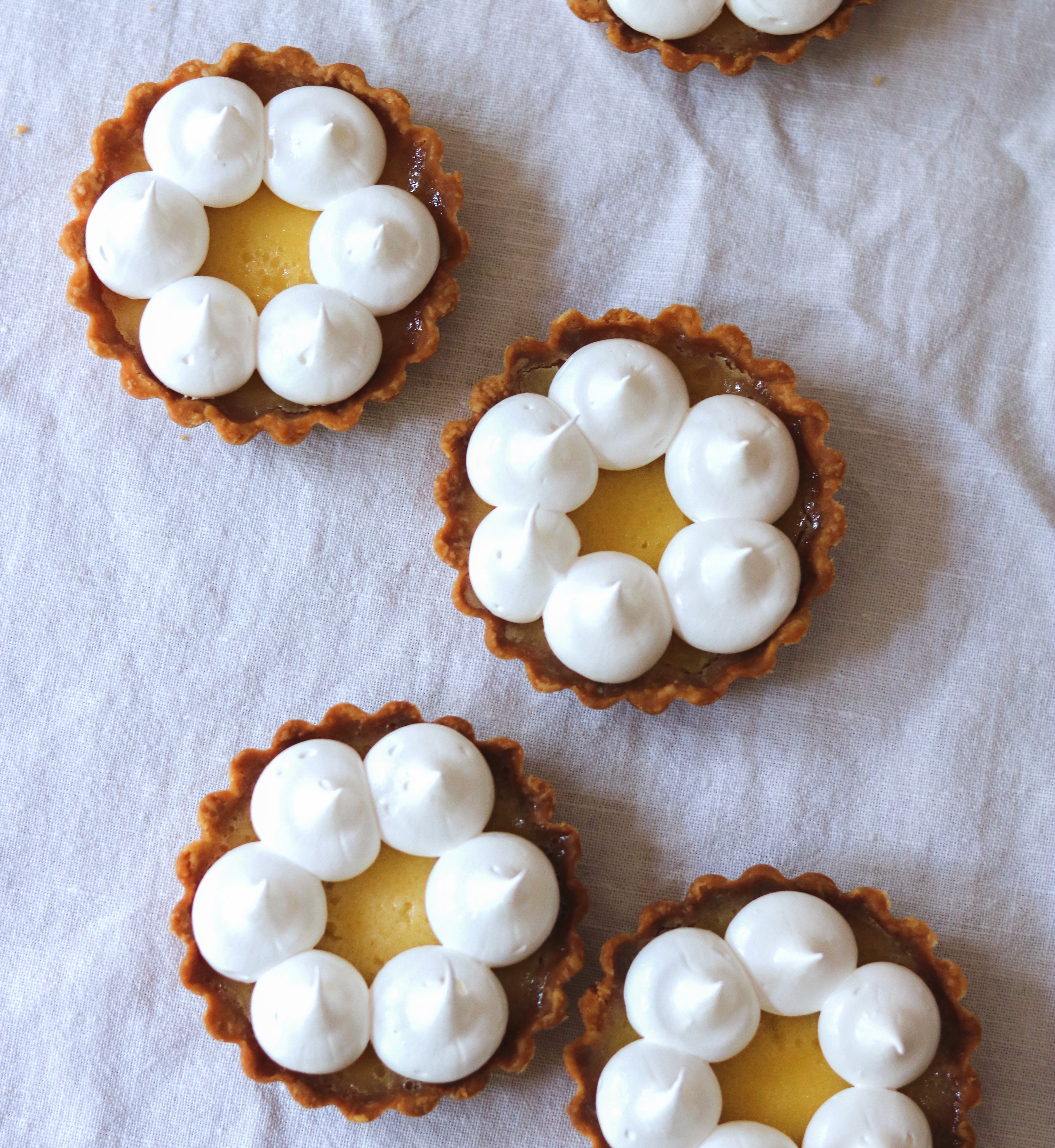
Prep 40min (+ pastry making time)Bake 35minMakes 10
Italian meringue makes an elegant topping for these classic tarts. You can caramelize the meringue lightly with a blow torch to add a delicate, slightly burnt caramel flavour to complement the sweetness of the meringue and sourness of the lemon filling if you wish.
Ingredients
1 quantity Sweet Shortcrust Pastry, rolled into a log about 15cm long before wrapping and chilling as directed
Icing sugar (optional), to sprinkle
Cream or ice cream, to serve
Filling
2 eggs110g (½ cup) caster sugar
125ml (½ cup) pouring (thin) cream
100ml strained fresh lemon juice
Italian Meringue
4 egg whites, at room temperature220g (1 cup) caster sugar
60ml (¼ cup) water
Method
-
Preheat the oven to 200°C (180°C fan-forced).
-
Remove the pastry from the fridge and cut into 10 even slices. Gently pat a pastry portion on a lightly floured benchtop with the palm of your hand to fatten slightly. Use a lightly floured rolling pin to roll out to a disc about 3mm thick. Line a 6.5cm (base measurement), 2cm deep, tart tin with removable base, with the pastry, pressing it into the side and corners with your thumb and/or fingertips. Roll the rolling pin over the top of the tart tin to trim any excess pastry. Repeat with the remaining pastry portions to make 10 tart cases in total.
-
Place the tart cases on an oven tray. Use a fork to prick the pastry base of each about 4 times. Line the pastry cases with squares of greaseproof paper or foil and fill with pastry weights, dried beans or raw rice, making sure they press into the corners and fill the cases. Bake in preheated oven for 10 minutes.
-
Remove the tart cases from the oven and use the paper or the foil to remove the weights from the cases. Return the cases to the oven and bake for a further 5-10 minutes or until the pastry is just cooked through and looks dry.
-
Meanwhile, to make the filling, use a fork to whisk the eggs, sugar, cream and lemon juice together until well combined. Strain the mixture into a jug. Pour the filling into the hot pastry cases while still in the oven (see Baker's Tips), dividing evenly. Reduce the oven temperature to 160°C (140°C fan-forced) and bake for a further 10 minutes or until the filling has just set in the centre but still wobbles slightly when shaken. Cool the tarts in the tins.
-
To make the Italian Meringue, put the egg whites in the bowl of a stand mixer fitted with a whisk attachment. Combine the sugar and water in a small saucepan and stir with a wooden spoon over low heat until the sugar dissolves. Increase the heat to medium and bring to the boil. Boil for about 10 minutes, occasionally brushing down the side of the pan with a pastry brush dipped in water to dissolve any sugar crystals, until the syrup reaches hard ball stage (120°C on a sugar thermometer).
-
Meanwhile, just before the syrup is ready, whisk the egg whites on high speed until firm peaks form. Remove the syrup from the heat and stand for a bout 1 minute or until the bubble subside. With the motor running on high speed, gradually add the sugar syrup in a thin steady stream until all the syrup has been incorporated. Continue to whisk on medium speed for another 10 minutes or until the meringue has cooled to room temperature.
-
Spoon the meringue mixture into a large piping bag fitted with a #13 (1.3cm) plain or #11 (1.1cm) star nozzle. Pipe small rounds of meringue over the surface of the tarts to cover. Use a blow torch to lightly caramelize the meringue if desired.
-
Dust with icing sugar, if desired and serve with cream or ice cream.
Baker's Tips
- Adding the filling to the pastry cases while still sitting in the oven will mean you can fill the tarts completely and minimise the chance of it spilling when transferring it to the oven.
- These tarts will keep in an airtight container in the fridge for up to 2 days (although the pastry will soften slightly on keeping). Bring to room temperature to serve.
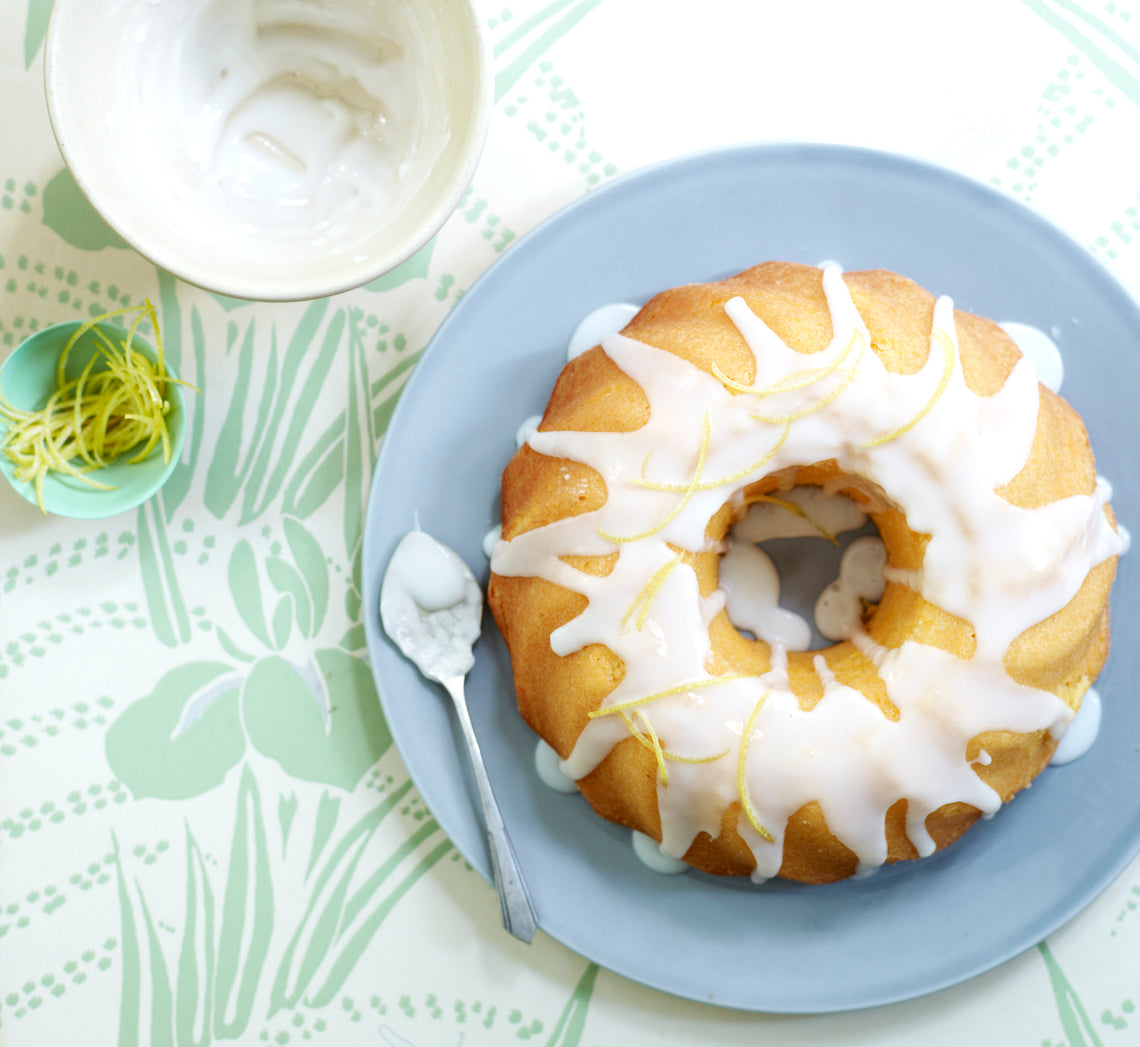
Prep 30minBake 40-45minMakes 10-12 serves
Lemon buttercake is something from heaven – rich, tart and mor-ish all at the same time… And when teamed with coconut it becomes sublime! This cake is particularly good for afternoon tea or dessert when teamed with vanilla ice-cream.
Ingredients
150g salted butter, softened
220g (1 cup) caster sugar
Finely grated zest of 2 lemons
3 eggs
300g (2 cups) self-raising flour
45g (½ cup) desiccated coconut
125ml (½ cup) milk
Candied Lemon Strips
220g (1 cup) caster sugar
250ml (1 cup) water
Lemon Drizzle Icing
125g (1 cup) pure icing sugar4-5 teaspoons strained fresh lemon juice
Method
- Preheat the oven to 170°C (150°C fan-forced). Grease a 24cm (top measurement) or 2.5 litre (10 cup) capacity fluted ring tin with the melted butter and dust with flour to lightly coat, tapping out any excess.
- Use an electric mixer to beat the butter, sugar and lemon rind in a large mixing bowl, scraping down the sides when necessary, until very pale and creamy. Add the eggs one at a time, beating well after each addition until well combined.
- Combine the flour and coconut. Add half of the flour mix to the butter mixture and mix on lowest speed possible until just combined. Add the milk and mix on lowest possible speed until just combined. Add the remaining flour mix and beat on lowest possible speed until just combined.
- Spoon the mixture into the prepared tin and use the back of a spoon to smooth the surface. Bake for 40-45 minutes or until a skewer inserted into the centre comes out clean. Stand the cake in the tin for 5 minutes to cool slightly before turning onto a wire rack sitting over a tray or plate.
- While the cake is cooling make the Candied Lemon Strips. Use a vegetable peeler to remove the rind in wide strips from the lemon. Use a small sharp knife to remove any white pith from the rind and then cut the rind into thin strips. Combine the sugar, water and lemon rind strips in small saucepan. Stir over medium heat until the sugar dissolves. Bring to a simmer and simmer for 10 minutes or until translucent. Use a fork to transfer the rind from the syrup to a plate, separating the strands. Set aside.
- When the cake is cool, make the Lemon Drizzle Icing. Sift the icing sugar into a medium bowl. Add 4 teaspoons of the lemon juice and stir until smooth and is a heavy coating consistency, adding a little more lemon juice, ¼ teaspoon at a time, until the desired consistency is reached. Use a spoon to drizzle the icing over the cake allowing it to run down the sides. Set aside for 10 minutes or until the icing sets.
- Transfer the cake to a serving plate, decorate with the Candied Lemon Strips and serve in wedges.
Baker's Tip
- This cake will keep in an airtight container for up to 2 days.






